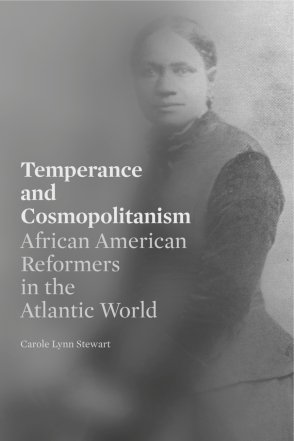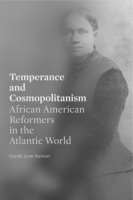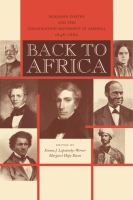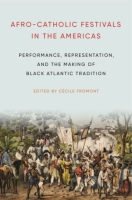
Temperance and Cosmopolitanism
African American Reformers in the Atlantic World
Carole Lynn Stewart
Temperance and Cosmopolitanism
African American Reformers in the Atlantic World
Carole Lynn Stewart
“This book speaks softly and carries a big wallop. Through precise readings and meticulous historical research, Stewart demonstrates that there was a common transnational epistemology uniting black reformers. Highly recommended.”
- Unlocked
- Description
- Reviews
- Bio
- Sample Chapters
- Subjects

An Open Access edition of Temperance and Cosmopolitanism is available through PSU Press Unlocked. To access this free electronic edition click here. Print editions are also available.
Both before and after the Civil War, white Americans often associated alcohol and drugs with blackness and enslavement. Carole Lynn Stewart traces how African American reformers mobilized the discourses o
f cosmopolitanism and restraint to expand the meaning of freedom—a freedom that draws on themes of abolitionism and temperance not only as principles and practices for the inner life but simultaneously as the ordering structures for forms of culture and society. While investigating traditional meanings of temperance consistent with the ethos of the Protestant work ethic, Enlightenment rationality, or asceticism, Stewart shows how temperance informed the founding of diasporic communities and civil societies to heal those who had been affected by the pursuit of excess in the transatlantic slave trade and the individualist pursuit of happiness.By elucidating the concept of the “black Atlantic” through the lenses of literary reformers,
Temperance and Cosmopolitanism challenges the narrative of Atlantic history, empire, and European elite cosmopolitanism. Its interdisciplinary approach will be of particular value to scholars of African American literature and history as well as scholars of nineteenth-century cultural, political, and religious studies.“This book speaks softly and carries a big wallop. Through precise readings and meticulous historical research, Stewart demonstrates that there was a common transnational epistemology uniting black reformers. Highly recommended.”
“Exploring a world torn by the foundational fractures forced by the system of slavery and racial control, Stewart uncovers a history of reform that challenges our understanding of place and mobility in African American history. She considers such writers as William Wells Brown, Martin Delany, George Moses Horton, Frances Harper, and Amanda Berry Smith, finding in their works a cosmopolitan determination to reorient American culture from the ground up. Anyone interested in African American literary and cultural history will want to read this important book.”
“An original, nuanced, and theoretically robust work of scholarship that will quickly prove to be a tremendous addition to our understanding of race, religion, politics, and public life. Stewart critically reads the multiple languages and expressions of freedom as amalgams that form and inform the multiple meanings of the world and human experience. By deeply probing the complex contours of the temperance movement against the backdrop of the Atlantic world, Stewart adds rich texture and offers fresh perspectives on this protean international movement.”
“In this study Carole Lynn Stewart shows how a group of enslaved, ex-enslaved, or fugitive African American women and men, through international travel, imaginative vision, and intellectual insight, critically expanded the practice and ideal of temperance from an individualistic, inner purity blind to the corruption of a civic order that tolerated slavery and enabled temperance to a serve as the vital basis for both the inward and societal meanings of freedom.”
“Stewart offers readers a theoretically rich, at times dizzying, account of the various ways Black creative writers, evangelists, and political activists connected cosmopolitanism to innovative practices of resistance and liberation.”
Carole Lynn Stewart is Professor of English Language and Literature at Brock University and the author of Strange Jeremiahs: Civil Religion and the Literary Imaginations of Jonathan Edwards, Herman Melville, and W. E. B. Du Bois.
From the Introduction
“Slave Travels and the Beginnings of a Temperate Cosmopolitanism”
It was Hegel’s genius to endow lordship and bondage with such a rich resonance of meaning that the model could be applied to every form of physical and psychological domination. . . . Above all, Hegel bequeathed a message that would have a profound impact on future thought, especially . . . Marx and Freud . . . : that one can expect nothing from the mercy of God or exercise worldly lordship in His or other names; that man’s true emancipation, whether physical or spiritual, must always depend on those who have endured and overcome some form of slavery.
—David Brion Davis, The Problem of Slavery in the Age of Revolution, 1770–1823
Race, Slavery, and Addiction
On May 1, 1851, the doors of the Great Industrial Exhibition of All Nations opened in the Hyde Park section of London. Under the administration and supervision of Prince Albert, Queen Victoria’s German consort, the exhibition had been in its planning stages for more than three years. While other world fairs had been held in Europe, the Great Exhibition—dubbed the “Crystal Palace” by the literary magazine Punch in recognition of the large three-tiered glass structure that housed it—emphasized the new technology of the Industrial Revolution and encouraged participation from all countries involved. In addition, the event’s organizers hoped to stimulate discussion and enhance the possibilities for free trade among the nations. Free trade would encourage the manufacture and dissemination of the products of industrial technology for worldwide consumption, thereby lessening the tension between nations and providing a basis for peace.
The Great Exhibition, the first international fair to which the United States had been invited, provides a cultural backdrop for this study. Between 1830 and 1860, a relatively large number of freed or formerly enslaved African Americans traveled to England seeking financial and political aid in their abolitionist cause. As a result, several African Americans who were fugitive slaves, or who had once been enslaved persons, were present in England in 1851 and attended the exhibition, one of the most prominent of whom was William Wells Brown.
The aims and goals of the Great Exhibition may be characterized by the hopeful words of Immanuel Kant’s “Idea for a Universal History from a Cosmopolitan Perspective.” Kant recognizes that human beings will increasingly be in a contest to exploit the earth’s resources, and in the treatise he sketches an Enlightenment rationale for a peaceful and cooperative exchange to take place. The concept of cosmopolitanism that Kant develops here may be overused in political and cultural theory but, despite its problems and associations with European colonialism, it is useful as part of the heritage of modernity. It stands to reason that abolitionists would engage with and reimagine the practice and meaning of cosmopolitanism, even if they do not explicitly name it. The term captures the ethical ideal of understanding or empathizing with the perspectives of other cultures and diverse traditions. Versions of “liberal cosmopolitanism” inherited from the Enlightenment have raised the problem of the universalizing tendencies of the liberal subject, with the capacity to distance from and yet sympathize with the sufferings of the other. While the Enlightenment definitions of cosmopolitanism derive mainly from Kant, the idea emerged in ancient Greece with Diogenes the Cynic in the fourth century bce. In that context, the term meant detaching from local customs and communities in favor of being a “citizen of the world” (or cosmos and city, as the two words were conjoined in ancient Greece). Then, as now, the term could be understood as somewhat of a sneer, particularly because Diogenes had little attachment to the idea of world citizenship or statehood. Some critics currently view the word negatively because of its association with the bourgeoisie, who had the relative luxury to travel and detach from local necessities, communities, and customs. While their experience does not fit that characterization, many escaped American slaves and abolitionist reformers traveled, founded new locations, and sought to reform oppressive communities in the African diaspora.
At the cosmopolitan spectacle of the Crystal Palace in 1851, American mechanical technology, ceramics, and horological skills were not comparable to those of many European nations. Despite this, the Americans requested forty thousand square feet of exhibit space, of which they used only twelve thousand. They were able to distinguish themselves in the areas of gun manufacture and mechanical reapers and in the yacht race. The one unique contribution of the Americans at this stage of the Industrial Revolution was the invention of that “peculiar institution” of human slavery in a modern democratic society—and the transformation of human beings into a peculiar species of property.
Obviously, the official American exhibitors mentioned neither enslaved persons nor the American institution and practice of slavery. The issue did arise, however, in relationship to a sculpture that was a part of the American exhibit. The American sculptor Hiram Powers presented a white marble piece titled “The Greek Slave.” When Powers exhibited in the United States from 1847 to 1849, the statue was accepted as the first public artistic display of nudity in the United States. The sculpture was of a nude white woman in the style of a Venus de Milo in chains. This was a negative tour de force, given the controversial topic of human slavery in England and the presence of African Americans and their English colleagues in attendance at the Crystal Palace. While the statue became an “emblem of freedom” for white Americans who romanticized the Greek cause in the Greek War of Independence, many also began to see its connection to the abolitionist cause of freedom in the United States.
William Wells Brown, along with William and Ellen Craft (both temperance reformers), attended the World’s Fair at the Crystal Palace. Brown was anything but sympathetic to the abstract display of sympathy for the European woman in chains. In his travel narrative Three Years in Europe, Brown describes going to the Crystal Palace with the express purpose of antislavery agitation because of the American slaveholding presence at the exhibit. In fact, he made a special effort to affront the sensibilities of his “Virginian neighbours” by strolling around the exhibit with “an English lady . . . on [his] arm.” Appearing a “gentleman,” he claims, “the Americans, as far as appearance goes, are behind every other country in the Exhibition. The ‘Greek Slave’ is the only production of Art which the United States has sent. And it would have been more to their credit had they kept that at home.” Brown brought the cartoon of the “Greek slave” from Punch magazine that parodied Powers’s statue with a more empirical version, titled the “Virginian Slave.” William Famer’s letter to William Lloyd Garrison notes that Brown “took ‘Punch’s Virginia Slave’ and deposited it within the enclosure by the ‘Greek Slave,’ saying audibly, ‘As an American fugitive slave, I place this ‘Virginia Slave’ by the side of the ‘Greek slave,’ as its most fitting companion.’”7 Notably, Brown’s performance was most offensive to white Americans because, in Farmer’s words, “to see the arm of a beautiful English young lady passed through that of a ‘nigger,’ taking ices and other refreshments with him, upon the terms of the most perfect equality, certainly was enough to ‘rile,’ and evidently did ‘rile’ the slaveholders who beheld it.”
In addition to Brown’s critical performance, he had created a panorama in 1850. Panoramas were popular during this period, and Brown was not the only creator of one depicting slavery; the escaped slave Henry Box Brown had also made use of the panorama as an aid to his abolitionist lectures in England. Upon arriving in England, Wells Brown decided to create a panorama as an aid to his lectures. He hired artists to illustrate his depictions and arranged them on a folded canvas. He also provided a pamphlet explaining each of the panels. Brown’s panorama showed the atrocities of slavery, including sale advertisements, attempted escapes, and whipping posts on plantations in Virginia and in the slave markets of New Orleans. The twenty-four panels clarify the international implications of American slavery, which could not be contained as simply a domestic issue. In some respects, the Industrial Revolution intensified slavery and had become part of the international discourse regarding civilization and economic exchange.
To be sure, Brown did not create his panorama for display at the American pavilion at the Crystal Palace. It could, nevertheless, be understood as a critical revision of the display of American art represented by Powers’s sculpture. At the first international exhibition to which Americans had been invited, the issue of slavery was expressed through an obfuscating avoidance by appealing to an effete classicism in a forum devoted to the marvels of scientific technology. That several English abolitionists and scores of ex-enslaved and escaped enslaved African Americans attended the exhibition reveals the extent to which the Americans were unprepared for a truly cosmopolitan and international discourse. And it is clear that those who had suffered some form of slavery were most capable of entering into this conversation.
The Crystal Palace Exhibition took place in the middle of the 1800s, at the midpoint of the first full century of the American republic, during which its cultural institutions, modes, customs, and sentiments were being established. One of the institutions was African American slavery, and with it the oppression of African Americans. Ira Berlin distinguishes between “societies with slaves” and “slave societies.” Societies with slaves permit human slavery as one of the legitimate institutions of the society, but the institution neither dominates nor has a formative position. In contrast, in slave societies, slavery acquires a pervasive and dominant position. Slavery in such societies permeates all other institutions; it is ubiquitous, influencing all the relationships, exchanges, and modalities of the society—in education, business, family, and all economic relationships. Berlin characterizes the American republic as a perfect example of a “slave society.”
Enslaved African Americans in the United States were enmeshed within the interstices brought into being by the Industrial Revolution, which determined the actualities and possibilities, styles, and discourses of the Western world during this period. Just as the Crystal Palace symbolized a cosmopolitan international achievement, the problematic nature of this era was well represented in the discourses of the moral philosopher and economist Adam Smith, the historian and economist Karl Marx, and, later, the sociologist Max Weber, in his classic discussion of the relationship between Protestantism and capitalism. Notably, none of these figures devotes serious attention to the problem of human slavery within the new industrial age. The Revolutions of 1848, which took place immediately prior to the Crystal Palace Exhibition, might have served as a warning in the midst of the celebration of industrial creativity. Likewise, the passage of one of the most oppressive fugitive slave laws in the United States portended the American Civil War, which was just over the horizon. Most of the slogans and advertisements celebrating the Great Exhibition as an expression of European cosmopolitanism emphasized some form of freedom resulting from the new technology. This sentiment, however, was not apparent to those who had been enslaved and oppressed within the United States.
In what follows, I examine the lives and works of five African Americans: Martin Delany, William Wells Brown, George Moses Horton, Frances Harper, and Amanda Berry Smith. In the words of Orlando Patterson, these authors and reformers suffered a “social death”: they suffered under slavery and experienced the oppression and degradation of a segregated society. Yet, each seeks and expresses a new form of freedom. The desired freedom possesses elements of Protestantism and capitalism, for some more than for others, but in none of these persons are these elements normative. Rather, the fragmented elements indicate the context of modern cosmopolitanism and industrialization. Each reformer pursues the creation of a moral community, which under an ideology of democratic freedom would mean a civil society. Since these African Americans were excluded or enslaved by a democratic free society, such a notion of freedom is problematic. Aware of this, they seek a society that acknowledges its shortcomings, is willing to make amends, and is capable of transforming the tragic into the redemptive. They seek a society of intimacy, at least within a common past, as well as a just social order.
Mailing List
Subscribe to our mailing list and be notified about new titles, journals and catalogs.







.jpg)